
When most people think about wine, they imagine flavor, color, maybe a fancy label, or how it pairs with food. But behind the scenes, there’s something that matters just as much—if not more—for wine brands: the packaging. What a wine bottle looks like, how it feels, and how it’s sealed can completely change the way someone sees the wine, even before they’ve taken a sip.
This might sound simple, but packaging does a lot more than just hold the wine. It tells a story, builds trust, and can even affect how the wine tastes over time. And for wine businesses, getting it right can be the difference between someone picking up their bottle—or passing it by.
Table of Contents
First Impressions Start with the Bottle
Let’s be real: when someone walks down the wine aisle, they’re looking at dozens—sometimes hundreds—of bottles. Most of the time, they don’t know much about what’s inside. That’s where the bottle comes in.
Shape, color, and weight all give off different vibes. A tall, thin bottle might hint at something light and crisp, while a dark, heavy one might feel more serious or bold. Even the color of the glass can change how people think about the wine. Clear glass can show off rosé or white wines, but it also means less protection from sunlight. Dark glass helps block UV rays, which keeps the wine fresher longer.
These choices aren’t just random—they’re marketing tools. A wine’s packaging helps it stand out and tells a customer, “Hey, this is the kind of wine you’re looking for.”
Why the Closure Really Matters
A big part of packaging that people often ignore? The closure. That’s the part that seals the bottle—usually a cork or screw cap. But this tiny piece makes a huge difference.
For example, traditional wine bottle corks do more than just plug the bottle. They help the wine age by letting a tiny bit of air in, which can make certain wines taste better over time. That’s why lots of wineries still stick with cork. Some even take it a step further and use natural cork made from special trees grown in places like Portugal.
If you’re curious about how corks are used and why they’re still popular, this guide on wine bottle corks explains it really well. It even shows how corks are chosen depending on the type of wine and how long it’s expected to age.
Screw caps, on the other hand, give a tight seal that’s great for wines meant to be enjoyed quickly. They’re easy to open, cost less, and don’t have the risk of “cork taint” (that weird musty smell when a cork goes bad). Some wine lovers used to look down on screw caps, but that’s changing—especially with younger drinkers who care more about convenience.
Both options have pros and cons. But the key is choosing the right one for the wine and the audience. Pick wrong, and people might not take the wine seriously—or might not like how it tastes after a year.
Labels: Not Just Decoration
A wine label does more than just sit there looking pretty. It gives the first clues about what the wine might be like. From the name and logo to the colors and font, every part of the label tells the customer something.
Is the label classic and elegant? That suggests a more traditional wine. Is it bold with bright colors? That could hint at a younger, fun brand. Some wineries even add textures or embossing to give the label a premium feel.
But it’s not just about looks. Labels also give important info: what kind of wine it is, where it’s from, what year the grapes were harvested, and even what foods it goes well with. All of this helps shoppers decide if that bottle is the right one for them.
Wineries that skip out on good label design or try to do too much can confuse customers—or worse, make the wine look cheap. And in a crowded market, that’s a big problem.
Packaging Has a Job to Do
While the outside matters a lot, packaging also has to do its job. That means keeping the wine safe from light, oxygen, and temperature changes. If the seal leaks or the glass is too thin, the wine might spoil before anyone drinks it.
Transport is another thing to think about. Wine bottles get shipped all over the place—in trucks, boats, even planes. The packaging has to hold up through all of that. If bottles break or labels get damaged, stores and customers notice.
And then there’s sustainability. More and more people care about how products affect the environment. Heavy bottles might look fancy, but they use more energy to make and ship. Some wineries are switching to lighter glass, recycled materials, or even boxes and cans to cut down on waste. These choices can help a brand connect with eco-conscious shoppers.
Brands Are Built on Trust
At the end of the day, packaging helps build trust. If a customer buys a bottle and it looks high-quality, opens easily, and tastes great, they’ll probably come back for more. But if the label peels, the cork breaks, or the wine tastes off—they might never buy from that winery again.
This is why serious wine businesses put time and money into packaging. They test different materials, work with designers, and plan everything down to the tiniest detail. It’s not just about looks. It’s about making sure the wine inside gets to the customer in the best shape possible—and making sure that customer is happy with what they get.
What It All Comes Down To
Packaging isn’t just the wrapping on a product. For wine, it’s part of the experience. It helps people decide which bottle to buy. It protects the wine inside. It shows off the brand’s values and style.
For wine businesses, this isn’t something to overlook. The right packaging can bring in new customers, keep regulars coming back, and even help the wine taste better. The wrong choices can do the opposite—and once someone has a bad experience, it’s tough to win them back.
So next time you see a wine bottle, take a closer look. There’s a lot more going on than just a fancy label.
Let’s Keep the Conversation Going
Good packaging combines design, science, and storytelling. When it’s done well, it makes people feel something—and makes the wine even more enjoyable. If you’re building a wine brand, or just curious about how the wine industry works, there’s a whole world of details behind every bottle on the shelf.
Want to talk more about it? Think about the last wine you bought—was it the label, the cork, or the shape of the bottle that caught your eye first? That choice might have been more important than you thought.


